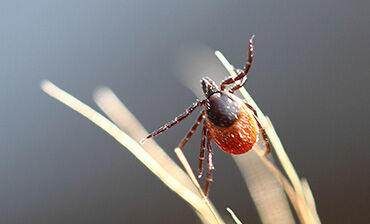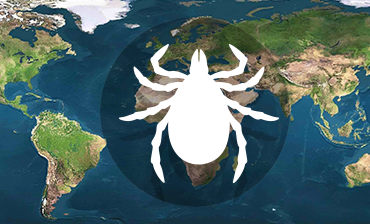Key messages about tick-borne encephalitis and tick-borne diseases

Key message 1: Ticks can carry disease
Ticks are abundant in woodlands all across Europe from early spring to late autumn. They live by sucking blood from animals and occasionally bite humans.
Ticks themselves do not cause disease but if a tick is infected with a virus or bacterium, then that pathogen can be transmitted through the tick’s bite and cause disease in humans.
Tick-borne encephalitis (TBE) is a common tick-borne disease in Europe (along with Lyme borreliosis).
The TBE virus can infect the brain and cause tick-borne encephalitis (brain inflammation). About one in four people infected with the TBE virus fall ill and develop symptoms of encephalitis which include high fever, severe headache, and sometimes paralysis and convulsions. Most patients with TBE encephalitis will recover but up to one third will suffer long-term complications of the disease.
There is no specific treatment for TBE once you are infected but there is an effective vaccine that prevents infection.

Key message 2: Tick-borne diseases are preventable
Tick-borne encephalitis (TBE) prevention
There are effective and safe vaccines against the TBE virus, and immunisation is recommended for people who live in TBE risk areas or who frequently visit forests and grasslands in TBE risk areas.
People who plan to visit TBE risk areas in Europe and Russia should consult their local doctor or immunisation services for advice about TBE immunisation.
Infected dairy animals can shed the TBE virus in their milk and there are documented cases of TBE transmission through infected milk, which is one reason why one should not consume unpasteurised milk or dairy products in TBE risk areas.
Tick-borne diseases prevention
The risk of tick-borne infections is reduced by avoiding tick bites and removing ticks from the body. Ticks live on the ground and climb 20 to 70 cm onto grasses and bushes where they find hosts with the help of temperature-sensitive cells. The bite is painless, and often you will not sense a tick moving on your skin.
The best ways to avoid tick bites are to:
- use insect repellent on exposed skin;
- wear protective clothing with long sleeves and long trousers tucked into socks or boots; and
- treat socks and trouser legs with permethrin-containing insecticide.

Key message 3: Tick-borne diseases are found only in certain geographical areas in europe
The risk of contracting a tick-borne infection is determined by the overall number of ticks in the area (tick density), the proportion of ticks in the area that carry disease (tick infection rate), and human behaviour (exposure). People engaged in recreational or occupational outdoor activities in a risk area are at increased risk of tick bites.
Most ticks are not infected with TBE virus and the risk of infection is small. TBE virus-infected ticks are found only in certain risk areas, and within these risk areas only a fraction of the ticks carry the virus (0.1–5%).
It is important to know where the TBE risk areas are and to take precautions to reduce the risk of infection if you are likely to be exposed.
The geographical distribution of TBE infected ticks within regions and countries is such that the risk of infection can change dramatically from one area to another within short distances. Many TBE-endemic countries communicate updated information on the risk of tick-borne diseases within their borders. Always check with local authorities about the risk of infection.
Countries with increased risk of TBE include Austria, Slovenia, Slovakia, Hungary, the Czech Republic, the Baltic States, southern Germany and southern and eastern Sweden. TBE is prevalent in Russia all the way from the western border with Europe to its eastern border. The TBE virus strain in Russia causes more severe disease than the central European strain and fatalities are not uncommon.
There is no common definition of what constitutes a TBE risk area in Europe. A TBE endemic area is an area where the TBE virus circulates between ticks and vertebrate hosts and can be transmitted to humans




